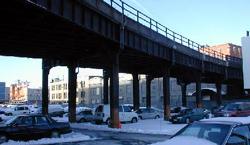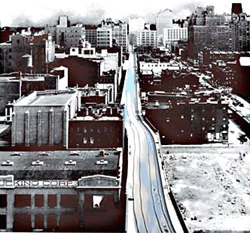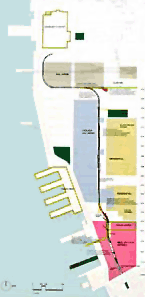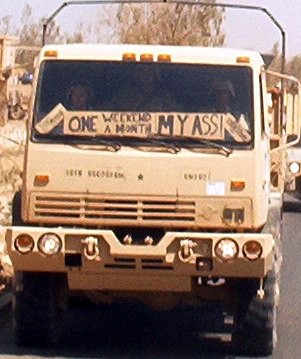July 2003
Eradicating Guinea Worm Disease
In 1986, Guinea Worm Disease infected an estimated 3.5 million people living in rural agricultural communities in 16 African countries, parts of India, Pakistan, and Yemen. The disease is extremely painful and debilitating, contracted by drinking water containing larvae of the parasite Dracunculus medinensis. The disease has plagued humanity for thousands of years. Today, after a decade’s campaign of education and the design and distribution of a special fabric, the disease has been virtually eliminated.
 “Dracunculus medinensis has been traced to calcified worms in the stomachs of Egyptian mummies during the first millenium. Records of infection and treatment have been found dating back to 1530 BC. The Guinea worm is believed to be the ‘fiery serpent’ mentioned in the Bible, that infected the Hebrews during their exodus from Egypt. The medical symbol ‘Caduceus’ is believed to represent two coiled Guinea worms.” [source]
“Dracunculus medinensis has been traced to calcified worms in the stomachs of Egyptian mummies during the first millenium. Records of infection and treatment have been found dating back to 1530 BC. The Guinea worm is believed to be the ‘fiery serpent’ mentioned in the Bible, that infected the Hebrews during their exodus from Egypt. The medical symbol ‘Caduceus’ is believed to represent two coiled Guinea worms.” [source]
A Sanskrit poem from the 14th century B.C. includes the plea, “Let not the sinuous worm strike me nor wound my foot.” [source]
“Victims must endure the worm’s painful emergence for as long as three months, and are usually incapacitated not only by the pain but by fever, fatigue, and nausea as well. To speed things along, people carefully wind the worm around a stick as it emerges [as depcted in the ‘Caduceus’], being careful not to pull too hard. If the worm breaks, it will retract into the body, causing severe inflammation. Over half of all worm-emergence sites become infected, and the worst cases can result in permanent crippling or even death from tetanus.” [source]
There is no preventive or curative drug. However, the disease is relatively easy to prevent — drinking contaminated water is the only way to acquire the disease.
“Measures to prevent [Guinea Worm Disease] are community-based and inexpensive. Control methods include health education, providing safe drinking water, using filters to remove infected copepods from drinking water, boiling water or treating it with small doses of temephos, a colorless, odorless chemical that, kills copepods but is harmless to people.” [source]
 “The cycle of transmission can easily be broken by filtering drinking water and preventing infected people from entering drinking water sources. [The worm] has no reservoir other than humans. When the worm’s one-year life cycle is broken for two years, the disease is permanently eliminated from the area. This is the only disease that can be eradicated by providing clean drinking water....
“The cycle of transmission can easily be broken by filtering drinking water and preventing infected people from entering drinking water sources. [The worm] has no reservoir other than humans. When the worm’s one-year life cycle is broken for two years, the disease is permanently eliminated from the area. This is the only disease that can be eradicated by providing clean drinking water....
Water contaminated with guinea worm is safe for drinking (as far as this disease is concerned) if the water is filtered through a tightly woven cloth.
Inexpensive, effective cloth is available in most local African markets, and 1 million square meters of special synthetic fabric, for more rapid water filtration, has been donated by DuPont, with additional synthetic cloth donated by the Danish government and others.
Agricultural and school projects, along with company advertising, can teach people about guinea worm and how to protect themselves. Farmers who drink from ponds during the day should have a filter with them.” [source]
The filter must always be used with the same side up, usually marked with a printed symbol or instructions.
Since 1986, local, national, and international campaigns have had dramatic success. The disease has been virtually eliminated.
“The Carter Center joined the fight against Guinea worm in 1986, when it helped Ghana and Pakistan launch their eradication programs. Since then, it has spearheaded the World Health Organization’s global eradication effort, aimed at making Guinea worm only the second disease, after smallpox, to be wiped out completely. Under the leadership of the Carters and Dr. Donald Hopkins, the Carter Center has raised money, provided technical expertise, forged partnerships, and mustered the political will necessary to achieve this ambitious goal. They have distributed portable filters and initiated education programs to help break the cycle of the worm.
Transmission has been stopped in seven countries, and Asia is now free of the disease. In 2001, fewer than 65,000 cases remained in thirteen African countries, a 98 percent reduction since the beginning of the effort. Experts are confident that total eradication is just around the corner.
In 2001, it was estimated that 80 percent of the remaining cases were in the Sudan, where civil war has prevented a major eradication effort. That same year, courageous Carter Center volunteers distributed 8.5 million pipe filters, enough for every man, woman and child in the endemic areas of the Sudan. These hard plastic straws with nylon filters at one end can be carried around the neck and allow nomadic peoples to strain their water before drinking.” [source]
At the request of President Carter in 1990, DuPont developed a nylon monofilament filtration fabric to filter water infested with the Guinea worm parasite. The fabric is manufactured by Precision Fabrics:
“This fabric was unique. It had never been produced in this country. It is woven using a very fine monofilament nylon yarn. The fabric is washed, stabilized and finished to control the pore size of the fabric. It is precision slit into 12-inch wide rolls for export to the countries plagued by the disease. The fabric is then used in villages to filter water sources.”
DuPont and Precision Fabrics donated millions of square yards of the fabric from 1990 to 1997. Other countries have also produced similar fabric filters.
...
The Guinea Worm Filter is my suggestion to “100 ‘Cubes of Good Ideas’”, an exhibition of “objects that change people’s lives.” Design for the World is organizing the exhibition, which takes place during the Universal Forum of Cultures in Barcelona in the summer of 2004.
One Weekend a Month My Ass!
A U.S. reservist in Iraq emails a photo to a friend back home. Friend posts it on his blog. The image is widely circulated by email, and ultimately finds mention in The New York Times a month later.
The war drags on. Tours of duty are extended. U.S. soldiers continue to kill and be killed. Dissent among the military and military families smoulders.
And the scholarship funding? Job skills? Veteran’s benefits? One weekend a month?
See these articles about the myths and messages in military graphics and advertising sold by recruiters to high school and college students across the United States of America.
The Living Machine
It looks like a botanical garden, but it’s feasting on your sewage — reclaiming waste water for reuse. It’s bioremediation in action. It’s... a Living Machine, “a natural engine to clean water, grow food, regulate climate, even repair damaged habitats.”

“Living Machines accelerate nature’s own water purification process. Unlike chemically based systems, Living Machines incorporate helpful bacteria, plants, snails and fish that thrive by breaking down and digesting organic pollutants.
Wastewater treatment takes place through a series of differently managed environments, a diversity of organisms that eat the waste in the water.
Each Living Machine is custom designed by the engineers of Living Machines, Inc.
Living Machines, Inc. designs each Living Machine to meet each individual client’s needs and requirements. Living Machines typically treat wastewater with six different steps (reactors) or ecologies.”
Though the outputs are not drinkable, there are a variety of agricultural and industrial uses for the processed water.
More than thirty commercial-scale and pilot facilities located throughout the United States and seven other countries, range in size between 300 and 750,000 gallons per day.
The Living Machine system in South Burlington, Vermont cleans 80,000 gallons per day of municipal sewage, an amount typically generated by approximately 1,600 residential users. The waste stream is diverted from the City’s conventional treatment plant. Waste water from the Ethel M Chocolates plant runs through a Living Machine system:
“The treated wastewater is suitable for reuse for on-site landscape irrigation. Sludge is also treated on-site by a composting reed bed, making this a zero discharge facility.”
...
Ocean Arks International is a non-profit organization founded by Living Machine inventor John Todd. Ocean Arks applies the concepts behind the Living Machine to restoring damaged environments.
“Restorer 1” is a floating Living Machine gobbling the contamination of Flax Pond in Harwich, Massachusetts.
“After Flax Pond in Harwich, Massachusetts, a popular swimming and fishing spot and source of irrigation for Cape Cod’s cranberry bogs, was closed in the mid-1980’s due to pollution, Ocean Arks deployed a ‘replacement wetland’: a sun- and wind-powered raft that cycles 100,000 gallons of pond water through nine ecological cells. Three cells harbor microbes to break down the contaminants, and the other six cells, containing typical marsh plants and animals, filter water that then returns to the pond.
Since the Lake Restorer began operation in 1990, beaches have reappeared, oxygen in the water has increased, and the biodiversity of bottom-dwelling invertebrates has blossomed. Although pollutants from the adjacent landfill and septic waste basin continue to leach into the pond from contaminated groundwater, the pond is again safe for swimming and fishing.” [source]
“During the first two years of its operation, the Restorer Living Machine assisted in the digestion of 19,000 cubic meters of anoxic sediments, greatly improving benthic diversity. Additionally, we estimate that the Restorer removes more than 5 kg of ammonia from the pond through denitrification each year in its EFB’s.” [source]
Tyson Foods’s $6 million dollar settlement with the Department of Justice for polluting Maryland’s water included funding for new measures to control the agricultural run-off. In 2001, Ocean Arks International installed an array of 12 “Restorers” to treat the industrial wastewater stream from the Tyson Foods plant in Berlin, Maryland.
Redesigning the High Line


“Designing the High Line” is an exhibition of ideas for the conversion of the High Line elevated rail structure to public space. The exhibit is showing in Grand Central Terminal until July 26. 720 entries were submitted from 36 countries. More than 100 of the proposals, including the competition winners, are displayed in the Grand Central exhibit. All 720 entries are displayed on the Web site.
In addition to the four principal winners, designs were selected for special cash awards for depicting the most compelling solution for universal access to the elevated structure, and for incorporating plants and wild flowers native to New York. (Pictures are posted here and here, though difficult to read.)
The High Line runs for 1.45 miles over Manhattan’s West Side, from 34th Street down through Chelsea to Gansevoort Street in the Meat Packing District. The High Line was built during one of New York City’s largest infrastructure projects, the West Side Improvement project. The project took place in the early 1930’s during the Great Depression and was presided over by Robert Moses. The Line carried freight above the streets of the West Side until 1980, when the last boxcars hauled a load of frozen turkeys down the tracks. The structure has been inactive since, collecting trash, shedding rust, and sprouting an elevated garden of weeds and wildflowers. [more history here]
In 1992, the Chelsea Property Owners, a coalition of two dozen businesses who own property under and near the Line — mostly parking lots, machine shops, warehouses, and the trendy Chelsea Market — won a conditional demolition order from the Surface Transportation Board. The proposal to tear down the Line was later supported by Mayor Giuliani. The plan never materialized because the coalition and the railroad’s owner at the time, Conrail, could not agree on an ultimate price tag for demolition. [source]
Through the economic boom of the 90’s, however, new residents moved into the neighborhoods below the Line, among them artists, designers, and galleries. In 1999, an altogether different group of neighborhood residents founded Friends of the High Line, a 501(c)(3) non-profit organization with the mission of converting the structure to an elevated public space.
 And, after much lobbying, it looks like the High Line might actually be redesigned. At the July 9 benefit preview of the exhibition, New York City Council Speaker Gifford Miller announced a $15.75 million funding commitment for planning and construction. The first $750,000 was allocated in the budget adopted by the New York City Council on June 27.
And, after much lobbying, it looks like the High Line might actually be redesigned. At the July 9 benefit preview of the exhibition, New York City Council Speaker Gifford Miller announced a $15.75 million funding commitment for planning and construction. The first $750,000 was allocated in the budget adopted by the New York City Council on June 27.
“The funds can be used for planning, design, and construction costs related to the High Line project during the fiscal year that began July 1. The remainder of the $15.75 million commitment will be allocated to the High Line in the following three fiscal years.
‘The High Line was built during the Depression to invigorate New York’s economy, and it will reinvigorate our City again today,’ said Speaker Miller. ‘As we have learned from our City’s great parks, public spaces create value and catalyze growth. Central Park was planned in a recession. Even in tough economic times, we have to invest in our future—by planning for the public projects that will keep us at the forefront of the world’s great cities.’
The funds will come from the City’s capital budget, which pays for project costs such as planning, design, construction, and long-term leases. The allocation will not affect municipal services, which are funded separately through the City’s expense budget.” [source]
 The Friends of the High Line are also seeking private, corporate, foundation, and federal funds for the project.
The Friends of the High Line are also seeking private, corporate, foundation, and federal funds for the project.
The competition follows two detailed planning studies: Reclaiming the High Line, sponsored by Friends of the High Line and the Design Trust for Public Space; and a comprehensive economic feasibility study, commissioned at the City’s request.
In December 2002, the City of New York took the first step in converting the High Line to a public walkway through federal rails-to-trails legislation. FHL is currently waiting on decision before Federal surface transportation board to allow City to move forward.
“As the next phase in its project to preserve and re-use the High Line, Friends of the High Line will hold a series of open workshops with members of the community beginning in September, with a variety of the competition proposals serving as springboards for discussion. At the end of 2003, Friends of the High Line will incorporate the community’s comments into a Request for Proposals, which will lead to the development of realizable designs.” [source]
The High Line is currently private property, owned by the rail company CSX Corporation. CSX acquired the High Line when it purchased Conrail in 1997. Conrail was created by the federal government in 1970’s from the remains of the New York Central and other railroads bankrupted by “competition from trucks, subsidized by the federally-built Interstate highway system, and an archiac system of economic regulations which prevented railroads from responding to the needs of the market.” The corporation was sold to the public in 1987, in what was then the nation’s biggest IPO. [more on Conrail] Though the High Line is private property, the federal government, specifically the Surface Transportation Board, has control over the Line as a piece of the nation’s rail infrastructure. CSX has been ordered by the government to work with all interested parties to effect the best exit strategy for the High Line, and to remain neutral as to the High Line’s outcome.
The City can not afford to purchase land under High Line, so has instead proposed rezoning and property transfer, moving air and development rights out to sites around West Chelsea. One potential consequence would be a wall of huge residential towers springing up along 10th and 11th Avenues in otherwise moderately sized manufacturing and retail zones. One challenge faced by city planners is the prevention such “massing.”
The High Line snakes through many neighborhoods and buildings, but sits almost entirely within the area served by Manhattan Community Board No. 4. The current Line blocks sunlight, collects trash, and drops water, rust, and pigeon droppings on the streets below. However, according to a survey by the Board, most community residents support conversion over demolition. They want to make sure, though, that the results of the redesign are the best damn park possible. The community is wary of new large-scale structures or billboards that would block sight of or access to the Hudson River. The project should provide open space for cultural programing, be accessible, and safe, providing a way to get up or down quickly. But most of all, it should connect with and respect the community. Some residential buildings sit within 5 feet of Line.
As development proceeds, areas beneath and adjacent to High Line will become lucrative spots for retail. Indeed, represenatives of our businessman-turned-Mayor is keen to move some of that retail up onto High Line itself. Other possibilities include constructing adjacent buildings with roof access that would meet the High Line or produce huge urban stairs, parks that terrace up to the bed of High Line, which is about 30 feet from the ground.
At a panel discussion, I asked Robert Hammond, co-founder of Friends of the High Line, about their advocacy strategy and how design competition fits into it. The competition took a year to organize from beginning to end and was a way to get people excited, to generate activism and support, and to provide a public platform for discussion. He noted the power of crazy, weird ideas - and how it is often easier to draw attention and support for the crazy ideas than the conservative plans. Another panelist noted that, when not located to a specific neighborhood, the constituency of public open space is transient and often does not have a consistent voice. The competition was an opportunity “to get those ideas out there.” Over the years, many have developed redesigns of the High Line for their thesis projects.
I asked Mr. Hammond what has led to their success to date while civic budgets are being cut and other projects around the city have faltered. Mr. Hammond proposed that the support base was “not the usual mix of neighborhood advocates.... The strongest supporters are architects, artists, art dealers.” Indeed a list of supporters at the gala benefit includes many A-list authors, actors, and artists. Not your usual city planning scene.
Mr. Hammond also noted that the design of their campaign materials was also key. Several designers have donated services to develop graphically sophisticated materials. Brochures, Web site, postcards for public comment... “Everything produced looks interesting. It suggests that the final design will be as innovative.”
Ironically, development of the High Line may push many in the arts community to leave the area. When the project is complete, rents around the Line are likely to increase. Many arts spaces are already midway through their 10 year lease, and unable to afford the current market rents. Part of the development plans could create public spaces that would not command retail rents and could support galleries, though these would be limited.
So how will the crazy ideas not get lost, or bogged down by politics? And allow ultimate designer to maintain poetic vision? The challenge is yet to come. Once New York realizes that the project is possible, everyone will want a piece of the action. It will be important to maintain a clear vision, and to make sure the final product is as extraordinary, interesting, and strange as the High Line itself.
Check out these photo galleries on the current state of the High Line.
The High Line was mentioned here in one of my first blog posts.
NYC Recycles Again
 Apologies for the lack of updates lately. I’m just back in town from travels and have a whole stack of notes to write up.
Apologies for the lack of updates lately. I’m just back in town from travels and have a whole stack of notes to write up.
In the meantime, I’m very happy to announce that New York City has started recycling again. Plastic recycling resumed on July 1. Glass recycling will resume in April 2004. Here’s the Department of Sanitation press release and poster.
Recycling was suspended last year as part of Mayor Michael Bloomberg’s plan to cut costs and fend off a projected $5 billion deficit. A year later, at a recent City Council budget hearing, Sanitation Commissioner John Doherty conceded that the projected savings from cuts to recycling never actually appeared. [source]
The City Council worked out the deal with the Mayor to resume recycling in a recent budget agreement.
The city will pay Hugo Neu Schnitzer East $51 per ton to handle the material, making the cost of processing the city’s recycling less expensive than processing its trash. According to HNSE, the city currently pays an estimated $105 per ton for the transportation and disposal of plastic and glass in the solid waste stream.
“[With the acceptance of the bid,] HNSE will build a multi-million dollar, state-of-the-art recycling facility in the Hunts Point section of the Bronx that will bring more than 40 high-paying, unionized jobs and numerous economic benefits to an impoverished area of New York City. Moreover, since HNSE operates one of the metropolitan area’s largest barge fleets, the development of the new recycling facility would create little additional truck traffic—indeed, the new facility would actually remove truck traffic from city roads and highways.” [source]
Building an recycling infrastructure in NYC is a wonderful thing, but I wonder about the environmental impact of the recycling plant itself. Residents of the South Bronx already endure much of the City’s waste transfer and incineration. Children living in East Harlem are three times more likely to have asthma than children living on the Upper West Side, and 25% of children from the South Bronx have asthma. As plans for the new recycling facility was just announced, the South Bronx Clean Air Coalition is seeking further information in order to evaluate the impact on health and traffic in the area.
Dell Stops Using Prison Labor
 This just in: yesterday Dell Computer announced it will use two new vendors for its electronics recycling, and will stop using a vendor that relies on prison labor. Congratulations to the many individuals and organizations involved in the campaign urging Dell to do just that. Just last week, the Silicon Valley Toxics Coalition released a report on the recycling processes used by Hewlett-Packard and Dell. The report contrasts the primative conditions and toxicity of Dell’s contractor, UNICOR, with the efficiency and safety of Hewlett-Packard’s vendor, Micro Metallics. The UNICOR facility is a maximum-security federal prison. The Micro Metallics facility is staffed by union workers paid a living wage.
This just in: yesterday Dell Computer announced it will use two new vendors for its electronics recycling, and will stop using a vendor that relies on prison labor. Congratulations to the many individuals and organizations involved in the campaign urging Dell to do just that. Just last week, the Silicon Valley Toxics Coalition released a report on the recycling processes used by Hewlett-Packard and Dell. The report contrasts the primative conditions and toxicity of Dell’s contractor, UNICOR, with the efficiency and safety of Hewlett-Packard’s vendor, Micro Metallics. The UNICOR facility is a maximum-security federal prison. The Micro Metallics facility is staffed by union workers paid a living wage.
A Dell spokesman denied that the decision was the result of public pressure, claiming both the decision to use UNICOR and the decision to drop it were based entirely on cost. UNICOR is a corporation run by the U.S. Federal Bureau of Prisons.
See this previous blog entry on the campaign.


